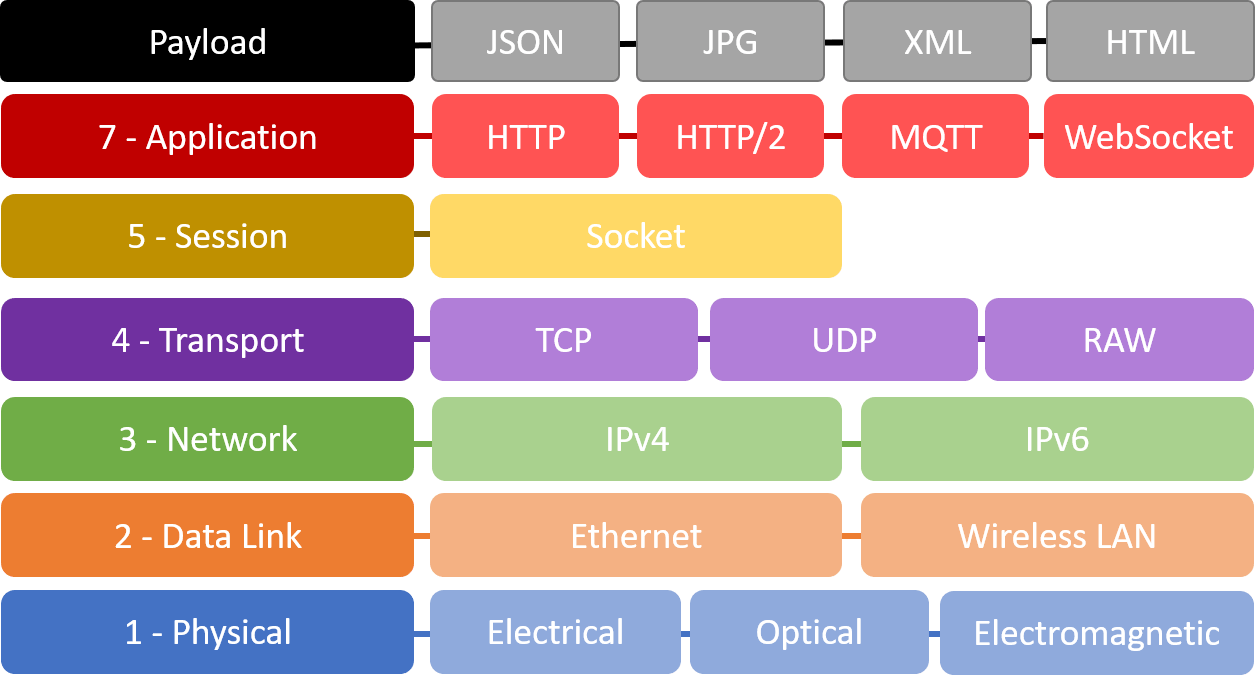L'expérience client dépend de la visibilité
Une enquête de Dimensional Research auprès de plus de 3 000 utilisateurs d’applications mobiles a confirmé ce que beaucoup d’entre nous pensent des attentes des clients d’aujourd’hui.
- Près de la moitié (49 %) s'attendent à ce que les applications répondent en deux secondes ou moins
- Plus de la moitié (55 %) considèrent l'application comme responsable des problèmes de performances
Ces statistiques liées aux performances peuvent être frustrantes car nous, en tant que professionnels de la technologie, comprenons que l’application n’est qu’une petite partie de l’équation des performances.
Nous savons que les performances des application sont positives. La mesure des performances application repose sur les performances de toutes les couches situées en dessous. Ce qui, dans le grand schéma OSI des choses, représente tout sauf le code et les données réels qui composent une application.
Considérez cette représentation (hautement simplifiée) de « la pile ». Chacune de ces couches possède ses propres profils de performance et défis. Même la couche physique peut avoir un impact considérable sur les performances des application . La dégradation de la puissance de votre modem câble, par exemple, peut entraîner une chute des performances des application , car en fin de compte, ce sont les signaux de la couche inférieure qui transfèrent les données. Si ces signaux se dégradent, les données devront peut-être être retransmises. La retransmission signifie qu'il faut plus de temps pour transférer l'intégralité du message. Cela entraîne une dégradation de l’expérience client, car tout ce qui repose sur un signal fort et stable est impacté négativement.

Je pourrais répéter cette relation tout au long de la pile. Les problèmes liés à la taille des fenêtres, les paquets désordonnés et un serveur Web surchargé contribuent tous aux performances globales de « l'application ». Si une couche ne fonctionne pas de manière optimale, il est probable que l' application le soit également. Les performances d’une application sont en réalité la somme de toutes les performances des couches situées en dessous.
Il a toujours été vrai que les services application par application sont la meilleure option pour gérer les performances des applications. L'utilisation de services d'application par application (dédiés) signifie que ces services peuvent être réglés spécifiquement pour répondre aux besoins de l' application.
Les passionnés de performances des applications savent que certains paramètres TCP sont meilleurs pour les sessions d'application de longue durée, tandis que d'autres sont meilleurs pour les transactions courtes et en rafales. De petits éléments comme le MTU au niveau de la couche réseau peuvent avoir un impact significatif sur le temps qu'il vous faut pour télécharger ce jeu de 20 Go pour votre Xbox.
Les performances des application sont affectées par de nombreux facteurs. Tout doit être optimisé pour chaque application si les organisations recherchent une expérience client optimale.
C'est pourquoi j'ai souligné à maintes reprises dans le passé que les performances (optimisation et accélération) sont un service centré sur les applications. Cela signifie de plus en plus que les services d’accélération des applications, tels que l’équilibrage de charge et la protection des applications, doivent être plus étroitement associés à l’application qu’ils servent. Les modèles de déploiement émergents basés sur les notions d'immuabilité, d'architectures cloud natives, de conteneurs et d'infrastructure en tant que code facilitent la capacité à déployer et à exploiter des services d'accélération, de protection et d'optimisation par application ainsi que leur application. Il s’agit d’éléments importants, car ce sont ces services qui contribuent à garantir que les applications, mobiles ou Web, répondent aux attentes des clients en matière de performances.
Mais nous ne pouvons pas nous arrêter là.
Nous ne pouvons pas oublier que la fourniture d’une expérience client optimale dépend également de la même pile dans l’environnement client. Les capacités de l’appareil, la puissance et la vitesse de la connexion, ainsi que la charge du système peuvent avoir un impact sur cette pile de variables et dégrader les performances.
Voici pourquoi les services applicatifs doivent bénéficier de visibilité. Les informations recueillies dans votre environnement client, combinées à celles de l’environnement applicatif, révèlent la véritable origine des problèmes de performance. Vous devez pouvoir ajuster ces environnements pour répondre voire surpasser les attentes de vos clients concernant leur expérience applicative.
La visibilité reste un élément clé de la capacité d’une organisation à sécuriser, faire évoluer et accélérer les applications. Plus nous distribuons ces applications (à travers des conteneurs, des clouds et dans des environnements clients), plus nous devons distribuer largement les services application qui peuvent garantir non seulement la visibilité mais aussi l’action face à la dégradation des performances.
